Introduction
Considering its price, the M3D650SV is a decent deal. VIZIO's 3D technology, as well as their smart platform, are both less rewarding than the parallel features found on Panasonic's VT50, but its core performance--color, contrast, as well as audio--are very good.
Design
Regarding the design, the M3D650SV is an ordinary 65-inch television, by contemporary standards. It's got a big, rectangular display panel and an unremarkable, average bezel. While it's on the thin side compared to VIZIO's E-Series, it wouldn't be considered thin within the LCD market. Its back is a dark, brushed metal that is pliable and feels a little flismy. The whole thing sits atop a large, oval-shaped stand that is black and heavy, enough to keep the 65-inch panel aloft.
The ports and port placement are standard. Perhaps the only interesting aspect of the M3D650SV is its Jag Wheel, a silver, quarter-sized wheel on the lower half of its right side that replaces the usual buttons for power, menu, input, etc.
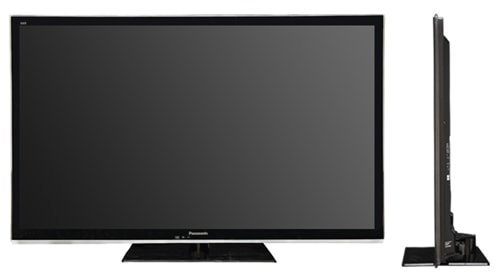
Front
{{section_header}}{{section.name}}{{/section_header}}

Back
{{section_header}}{{section.name}}{{/section_header}}

Sides
{{section_header}}{{section.name}}{{/section_header}}

Stand/Mount
{{section_header}}{{section.name}}{{/section_header}}

On-set Controls
{{section_header}}{{section.name}}{{/section_header}}
The "Jag Wheel" (see photo) has replaced standard on-set controls for the VIZIO M-Series. It serves to replace almost all of the usual on-set controls. Pressing the wheel will turn the TV on. Spinning it will raise and lower volume, respectively. Pressing the wheel while the TV is already powered on will bring up a quick menu, allowing you to use the wheel and adjust volume, channel, and input source by clicking and spinning as need dictates. If you hold the Jag Wheel for three seconds, the TV will power off.
We think it's kind of cool, and it makes finding the "power" button in the dark a lot easier when there's only one button.

Remote Control
{{section_header}}{{section.name}}{{/section_header}}
From one side, VIZIO's infrared remote looks like any other: navigational buttons, volume and channel controls, a number pad, and three buttons dedicated to the TV's top apps: Amazon Instant Video, Netflix, and VUDU. It's a slightly larger version of the little remote that comes packaged with VIZIO's E-Series.
On the flip side, however, is a small keypad, a set of navigational buttons, and colored A, B, X, and Y buttons meant for quickly navigating VIZIO's wireless apps. This isn't the first time VIZIO's made use of this 2-sided qwerty remote. The keypad side of the remote is meant to be held horizontally (as opposed to the vertical inclination of a standard infrared remote). It sends a signal to the TV via a small area just to the left of center on the front of the keypad, which is occasionally blocked by your left hand, but works alright 90% of the time.
Overall, both remotes are fairly sluggish--not due to their signal, but due to the TV's processing power. Typing in phrases on the keypad is certainly quicker than using the standard navigational errors, but it's still not as quick as a USB keyboard, and must be done slowly and carefully. As a package, it's a decent remote, but its whole is stronger than the sum of its parts.

In the Box
{{section_header}}{{section.name}}{{/section_header}}
In the box, you'll find the 65-inch display panel, the stand components, 14 screws (and a screwdriver), 4 pairs of passive 3D glasses, the 2-sided remote/qwerty keyboard, a quick-start guide, and the power cord.
Connectivity
{{section_header}}{{section.name}}{{/section_header}}
The M3D650SV's ports are located in standard location along the left side of the TV, and in a small, recessed area on the left, back side--just around the corner from the jag wheel. They're placed in a sensible and accessible fashion, but the non-swiveling stand makes the back placement ports a little harder to access than if the stand did swivel.
The side ports are generally the ones you'll need access to most often, and feature inputs for four HDMI cables and two USB flash drives. Their proximity to the edge of the TV can make plugging in a bulkier HDMI cable feel a little cramped, but they work for the most part. Below the HDMI and USB inputs, you'll find output ports for optical and stereo audio.
The back ports are vertically inclined and give you a place to plug in your PC (via VGA connection); your PC audio; a component (or composite) AV connection; and a coaxial jack, for cable or antenna connection.
Overall, this is a decent selection, but you're not getting anything too fancy. Still, the connectivity spread is of the same variety as other high-end TVs.

Performance
VIZIO's 65-inch M-Series tested with supremely accurate color curves, a decent color gamut, and almost perfect color temperature. We love to see a TV that knows how to produce accurate, consistent color. In the area of blacks and whites its contrast ratio is just shy of 4000:1, which is a great result for any kind of TV, and its got almost flawless picture dynamics. It's a special bonus that its two 15-watt speakers produce above average audio.
Unfortunately, it didn't do quite as well during our screen performance tests. Its got a very narrow viewing angle, meaning if you want the best contrast you're going to have to watch from almost dead center. It showed us blurring and artifacting during our motion performance tests--nothing that destroys its useability, but it does mean that it doesn't handle fast-action content as well as it could, and should.
Essentially, the mild motion problems and narrow viewing angle don't detract too heavily from its excellent color and contrast performances.
Contrast
{{section_header}}{{section.name}}{{/section_header}}
We were taken aback by the narrow contrast ratio we measured for VIZIO's E-Series (below), and thus were relieved to see that this TV, the M3D650SV, has a very respectable maximum contrast ratio of 3933:1. The chart below illustrates that this inexpensive LCD holds it own against a mid-range Sharp and Samsung's flagship, the ES8000. More on how we test contrast.

Color & Greyscale Curves
{{section_header}}{{section.name}}{{/section_header}}
The VIZIO M3D650SV tested with very smooth, accurate color curves. While they're a little slow to ramp up (meaning that dark shadows will appear as a flat black, bereft of detail), your midtones will transition smoothly to the brightest highlights. Just like the E-Series, VIZIO's M-Series showed us excellent results in this area. More on how we test color performance.

Color Temperature
{{section_header}}{{section.name}}{{/section_header}}
Take a glance at the chart below. The orange and blue bumps peaks and valleys show the M3D650SV's deviations from a perfect color temperature. This is an excellent result for any TV, as only the darkest edge of the light input spectrum shows real problems. That means that your shadows might "warm" a little, or turn yellow-orange, but they'll probably be so dark you won't even notice. More on how we test color temperature.

Color Gamut
{{section_header}}{{section.name}}{{/section_header}}
We test a TV's color gamut (white, red, green, and blue) against the rec. 709 standard color gamut. The black line below represents that standard--for all intents and purposes, this can be considered perfect within the world of HDTVs. The white triangle shows how the M3D650SV performed. Green, red, and white (the circle in the middle of the triangle) are spot on, which is very good. The blue point was somewhat undersaturated, meaning it wasn't imbued with enough light to meet the rec. 709 standard, but still this is a great result. More on how we test color temperature.
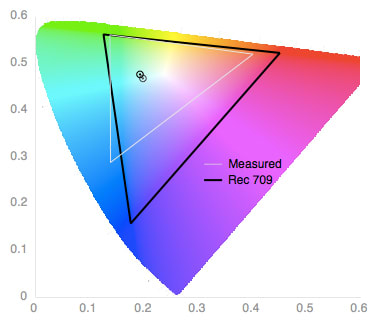
Picture Dynamics
{{section_header}}{{section.name}}{{/section_header}}
Like the VIZIO E-Series, the 65-inch M-Series tested with excellent picture dynamics. To test picture dynamics, we take a reading of light output (in candelas per meter squared), comparing outputs between varying degrees of black and white on a TV's screen. For LCDs like the M3D650SV, we want to see white/black light saturation staying the same regardless of how much white/black is on the screen. This TV proved to have very reliable picture dynamics, maintaining the same brightness and black level regardless of which hue held the majority of the screen. A very good result. More on how we test picture dynamics.
Resolution & Formats
{{section_header}}{{section.name}}{{/section_header}}
The VIZIO M3D650SV is a native 1080p, Smart, 3D, LED LCD HDTV. It supports all NTSC resolutions and formats.
Viewing Angle
{{section_header}}{{section.name}}{{/section_header}}
The M3D650SV tested with a total viewing angle of 45°--less than average for an LCD television. Next to the TVs we used for comparison, it's small but not terrible. You're only going to be able to watch from around 23.5° from center on either side, meaning only a small handful of people will be able to watch with perfect contrast. If you want a wider viewing angle, there are definitely better LCD TVs, but plasmas invariably have the widest viewing angle.

Motion Performance
{{section_header}}{{section.name}}{{/section_header}}
The motion we saw from the 650SV M-Series was plagued by the same mild but noticeable problems as the lower-end E-Series: blurring, artifacting, and mild shape distortion during motion-heavy video sample. Details were lost in the blur, though color and overall shape were fine. The complex motion of banded pixels caused a noticeable, rippling trail of artifacts as the TV struggled to refresh quickly enough to create the illusion of smooth motion.
Not a terrible performance, but we've seen better from TVs that aren't as decked out with extra features as this one is.
{{product.manufacturer_specs['Motion Performance Image']}}
Screen Uniformity
{{section_header}}{{section.name}}{{/section_header}}
The M3D650SV has an edge-lit LCD screen, which causes a lot of light bleed-in during shadow-edged scenes. While the centers of all black and all white screens were perfectly uniform, the black screen's corners were probably about .099 cd/m2 lighter than the center, which really destroys shadow uniformity.
This is, again, the same result that we saw from the E-Series, and is something VIZIO needs to tweak.
{{product.manufacturer_specs['Screen Uniformity Image']}}
Audio Quality
{{section_header}}{{section.name}}{{/section_header}}
Most HDTVs come standard with two 10-watt speakers. The wattage refers to the amount of electrical power allocated to the speakers, and in turn, their audio output and quality. The VIZIO M3D650SV has two 15-watt speakers embedded along the bottom of the TV, beneath the bezel, and the increased wattage makes a surprisingly big difference. This TV is plenty loud at just half maximum volume, and it handles treble/bass output well, giving ample clarity to machine gun fire, explosion, voices, and musical score.
Like the E-Series, VIZIO's M-Series features an EQ menu that allows for manual adjustment of treble/audio balance, as well as a setting called SRS TruVolume, which (while on) attempts to make standard content louder and clearer, and commercial advertisements less so. Ever been watching an older movie, and had to turn it up, only to find that the modern, interspersed commercials are then way too loud? Essentially, the TruVolume setting tries to solve that problem, with decent results.
The M3D650SV also has a surround mode, called SRS StereoSurround HD, which does an alright job at imitating surround, but it really only works with spoken dialogue; music and sound effects still sound like they're coming straight at you from the TV speakers.
Overall, VIZIO's 15-watt speaker set-up makes for above average audio quality, even if it raises the TV's power consumption a good deal.
Power Consumption
{{section_header}}{{section.name}}{{/section_header}}
As you can see from the chart below, this TV uses an almost outrageous amount of power, consider that it uses LED backlighting, the distinguishing feature of which is energy efficiency. The results were unusual enough that we retested a few times and came up with the same number. Another Vizio LCD TV we tested this year, the E-Series, consumed even more power, so we can only guess that it's something in the Vizio TVs this year.
Compared to similarly priced and even more expensive LED LCD televisions, the M3D650SV is very pricy. It'll cost the average user about $30 a year to power, given 4-6 hours a day of use. At maximum backlight, that number skyrockets to over $50 a year; yet the M-Series still doesn't use as much electricity as the less expensive E-Series.
Either way, VIZIO has obviously not yet implemented the same kind of energy saving technology that other companies (like Samsung and Sharp) have been using for a couple of years now.
{{comparison_bars title="Average Cost Per Year", attribute="Minimum Recommended Cost per Year Measured", xLabel="Dollars"}}
Calibration
{{section_header}}{{section.name}}{{/section_header}}
We had to tweak a few settings, but for the most part, the VIZIO M3D650SV proved simple to calibrate. We attempt to maximize color detail across the high end of the spectrum while still maintaining good shadow detail, essentially pushing the TV to perform to its max without erring in any one area. The chart below details our final calibration of the VIZIO M3D650SV.
All of our calibration is done in conjunction with the DisplayMate software.
Video Modes
{{section_header}}{{section.name}}{{/section_header}}
The VIZIO M3D650SV has 9 pre-set Video Modes.
3D
3D is a finicky topic both to test and to write about. Trying to describe subjectively how it "looks" can be difficult, as the 3D experience is largely subjective and varies widely with different manufacturers employing different technologies.
VIZIO's 3D looks decent, but it's a far cry from the 3D trickery that your brain undergoes on an IMAX screen. It's a subtle effect, which is good and bad. There's very little crosstalk (when images bleed into the wrong eyes and create a halo), but there's also nothing very breathtaking about the 3D itself. We recently went to see Prometheus in IMAX 3D, and the sense that we were looking back into a non-2D plane was very convincing, even to our skeptical brains. That feeling is entirely absent from VIZIO's technology; the difference between a movie in 2D and a movie in 3D is very mild, though thankfully the contrast and color integrity remains strong.
If you're looking for a VIZIO TV with a convincing and immersive 3D mode, you may want to wait another year. If you're okay with "3D lite," then you'll be pleased with the M3D650SV's ability to maintain its contrast and color during 3D viewing.
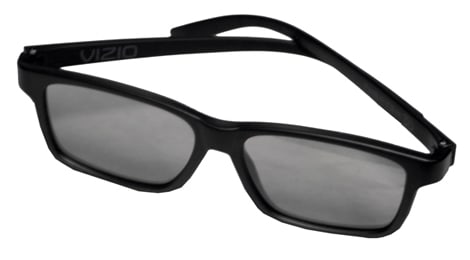
3D Effect & Experience
{{section_header}}{{section.name}}{{/section_header}}
The 3D we saw from the M3D650SV was alright, but nothing about it was very impressive. There was almost no crosstalk, but this is directly related to the "mildness" of the 3D; the side-by-side images aren't far enough apart to create crosstalk, but their lack of distance means a very limited depth of field between foreground and background 3D effects. You'll still know you're watching 3D, but just barely.
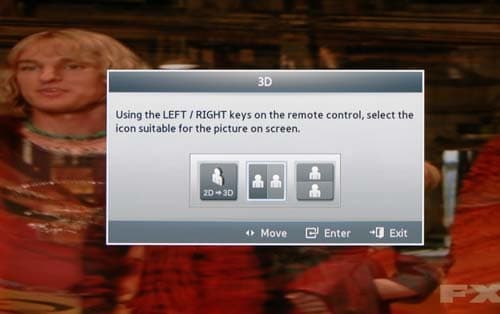
Some of the options in the 3D menu
VIZIO's passive 3D glasses are lightweight, fit well over average-sized spectacles, and can be worn for a considerable amount of time without growing annoying. They're large enough to cover the extent of your vision without being heavy or cumbersome. Best of all, the M3D650SV ships with 4 free pairs, and on average a new pair of glasses costs about $25, meaning it's much cheaper to keep a family supply of VIZIO passive 3D glasses than more expensive, active shutter 3D glasses from Panasonic or Sony.
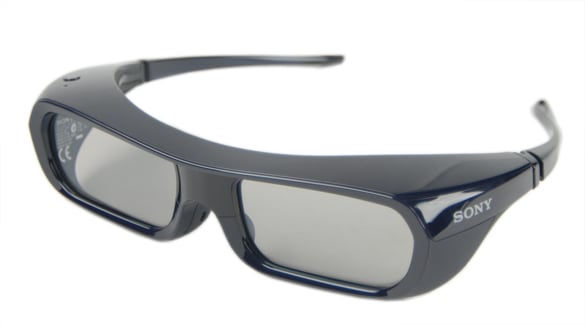
Yes, you will look like a dork with these on
3D Contrast
{{section_header}}{{section.name}}{{/section_header}}
Every now and again we'll see a TV with a larger maximum contrast ratio in 3D than in 2D, and the VIZIO M3D650SV is one such model. Its peak brightness of 314.64 cd/m2 was cut down to 120.92 cd/m2 during 3D viewing, but its 2D black level of 0.08 cd/m2 dropped, considerably, to 0.03 cd/m2 , giving it a 3D contrast ratio of 4031:1, which is a very strong result.

3D Color
{{section_header}}{{section.name}}{{/section_header}}
The M-Series' 2D color temperature was excellent, only showing visible deviation from the 6500° K standard at the very darkest input spectrum. Unfortunately, this excellence did not carry over to 3D viewing, and the orange/blue hues that escape the opaque rectangle of imperceptibility (in the chart below) mean there is visible color temperature error throughout most of the brightness spectrum during 3D viewing. It's a shame, but many companies are still trying to implement 3D without wrecking their television's color integrity.
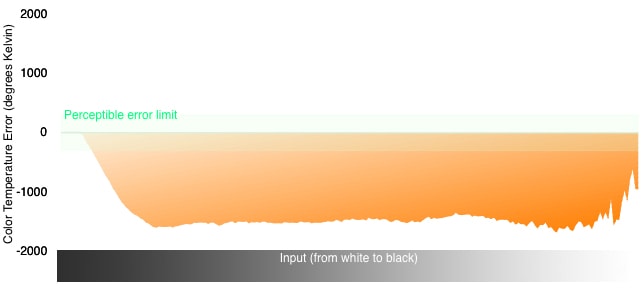
Again, 3D has dashed the hope of impeccable color accuracy against three-dimensional rocks. The M-Series tested with very accurate gamma and color curves during 2D viewing, but the addendum of polarized sunglasses skews its 3D color curves, causing them to ramp at different speeds and become choppy and inaccurate. The choppy motion means that, while it would be hard to notice, some colors will "jump" to the next hue without a smooth transition during 3D viewing. The different curve speeds (ramps) means that colors will be darker/lighter than they should be, or more simply, contain luminance errors. This is a bad result, but it won't be hugely noticeable during viewing. Of course, neither will the 3D effects.
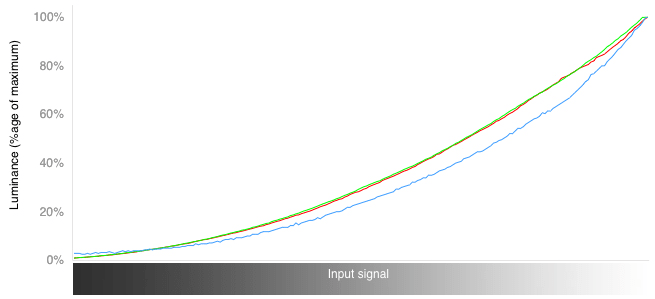
Unlike its 3D temperature and 3D curves, the M3D650SV's 3D gamut was quite accurate when put up against its 2D gamut (both are pictured below). This is a good result, as it means the brightest points of white, red, green, and blue are still more or less the same color in 3D as they are in 2D.
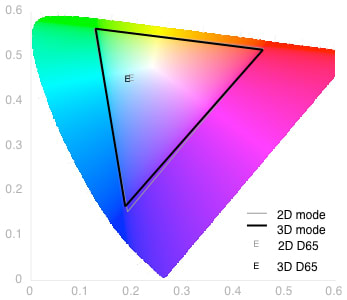
3D Crosstalk
{{section_header}}{{section.name}}{{/section_header}}
The VIZIO M3D650SV's mild, almost imperceptible 3D had no crosstalk problems, but considering it looked more like a 2D-to-3D conversion setting than full HD 3D, that's hardly surprising. Expect to be able to watch almost any content without any major crosstalk problems, as the TV--despite being over 50 inches wide--simply doesn't offer the kind of in-your-face 3D that typically causes crosstalk.
Software & Internet
Apps
{{section_header}}{{section.name}}{{/section_header}}
Pressing the stylized "V" at the center of your remote will bring up a horizontal menu of apps along the bottom of the screen. Yahoo! has provided apps for news, weather, and even stock market information, but they're pretty limited, and can really only be interfaced with by creating a VIZIO user profile and entering some personal information. Where social networking is concerned, users have access to Skype and Facebook, but their respective interfaces are limited at best, and take longer to load than they should for only taking up a third of the screen. Besides these, the most noteworthy apps on Vizio's platform are Netflix, VUDU, Amazon Instant Video, and Rhapsody.
Click here for more information on VIZIO's available apps.

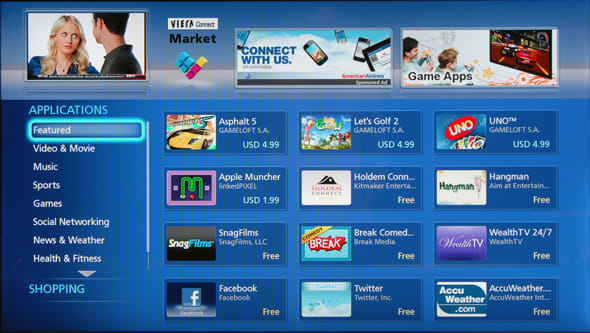
Other Internet Features
{{section_header}}{{section.name}}{{/section_header}}
While it's not internet content, you can play back your personal media items (pictures, music, or videos) from your VIZIO TV as well. Plugging a USB flash drive into one of the two USB ports will bring up a fairly stripped down menu that divides your content by photo, music, or video, and then lists those files--though we would like to warn that it seems VIZIO's TVs only support particular file types, and sometimes even have trouble with standard .jpeg files.
For more information on VIZIO's smart platform, and a more in-depth look at their USB playback system, click here.

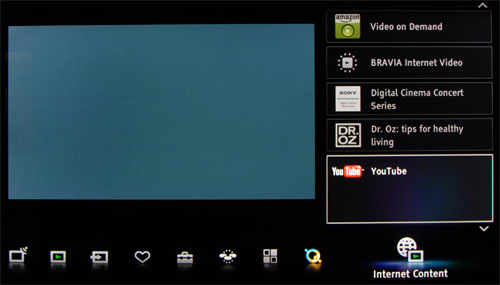
Menu Interface
{{section_header}}{{section.name}}{{/section_header}}
Pressing the "menu" button on the included infrared remote will bring up the grid style menu, which consists of some traditional sub menus, like Picture, Sound, Settings, and Network. Included with the M-Series (and with VIZIO's 2012 models with 3D) is also a 3D menu for selecting 3D side-by-side or top-to-bottom. For the most part, the menus are basic and simple, which makes them easy to navigate, though the navigation itself is fairly sluggish, and the infrared signal from the remote doesn't always connect with the TV's infrared sensor.

The Picture menu (below) will allow the user to select from VIZIO's staggering number of Video Modes (see our Calibration section for more info), as well as setting things like Backlight, Sharpness, Digital NR, and any motion smoothing effects you (hopefully) will opt out of. The Picture menu comprises a couple of separate pages, but most of the other menus are a single page of options.

Conclusion
{{product.vanity}}
VIZIO's 65-inch M-Series, the M3D650SV ($2199 MSRP), is a strong core performer that'll save you money, but its unique features run the gamut from fairly interesting to hardly worthwhile. Where core performance is concerned, the M3D650SV has very good contrast, color, and black/white dynamics. It's also got speakers with a higher wattage than the average HDTV, so its sound output is both generally louder and of higher quality. Unfortunately, that color integrity doesn't carry over to its 3D technology--which is also so mild that it's almost not worth using.
The M3D650SV has decent connectivity options, but most of its other features are simply average. VIZIO's smart platform is probably in last place when compared to their competitors. Finally, it's probably the least attractive flagship TV out there, but for the price you're paying for a 65-inch TV, that might not be a hard pill to swallow.
Photo Gallery
{{photo_gallery "Design Landing Page Photo", "Front Tour Image", "Back Tour Image", "Sides Tour Image", "Connectivity Tour Image 1", "Connectivity Tour Image 2", "Stand Photo", "Controls Photo", "Remote Control Photo", "3D Landing Page Photo", "3D Menu Photo", "3D Glasses Photo", "Connectivity Extra Photo", "Software and Internet Landing Page Photo", "Menu Main Photo", "Menu 2 Photo", "Instruction Manual Photo", "Internet Features 1 Photo", "Internet Features 2 Photo", "Internet Features 3 Photo", "Local Media Playback 1 Photo", "Local Media Playback 2 Photo", "Browser 1 Photo", "Browser 2 Photo", "Browser 3 Photo", "Apps 1 Photo", "Apps 2 Photo", "Apps 3 Photo"}}
Ratings & Specs
{{manufacturer_specs_table}}
Meet the tester
Lee was Reviewed's point person for most television and home theater products from 2012 until early 2022. Lee received Level II certification in TV calibration from the Imaging Science Foundation in 2013. As Editor of the Home Theater vertical, Lee oversaw reviews of TVs, monitors, soundbars, and Bluetooth speakers. He also reviewed headphones, and has a background in music performance.
Checking our work.
Our team is here for one purpose: to help you buy the best stuff and love what you own. Our writers, editors, and lab technicians obsess over the products we cover to make sure you're confident and satisfied. Have a different opinion about something we recommend? Email us and we'll compare notes.
Shoot us an email


